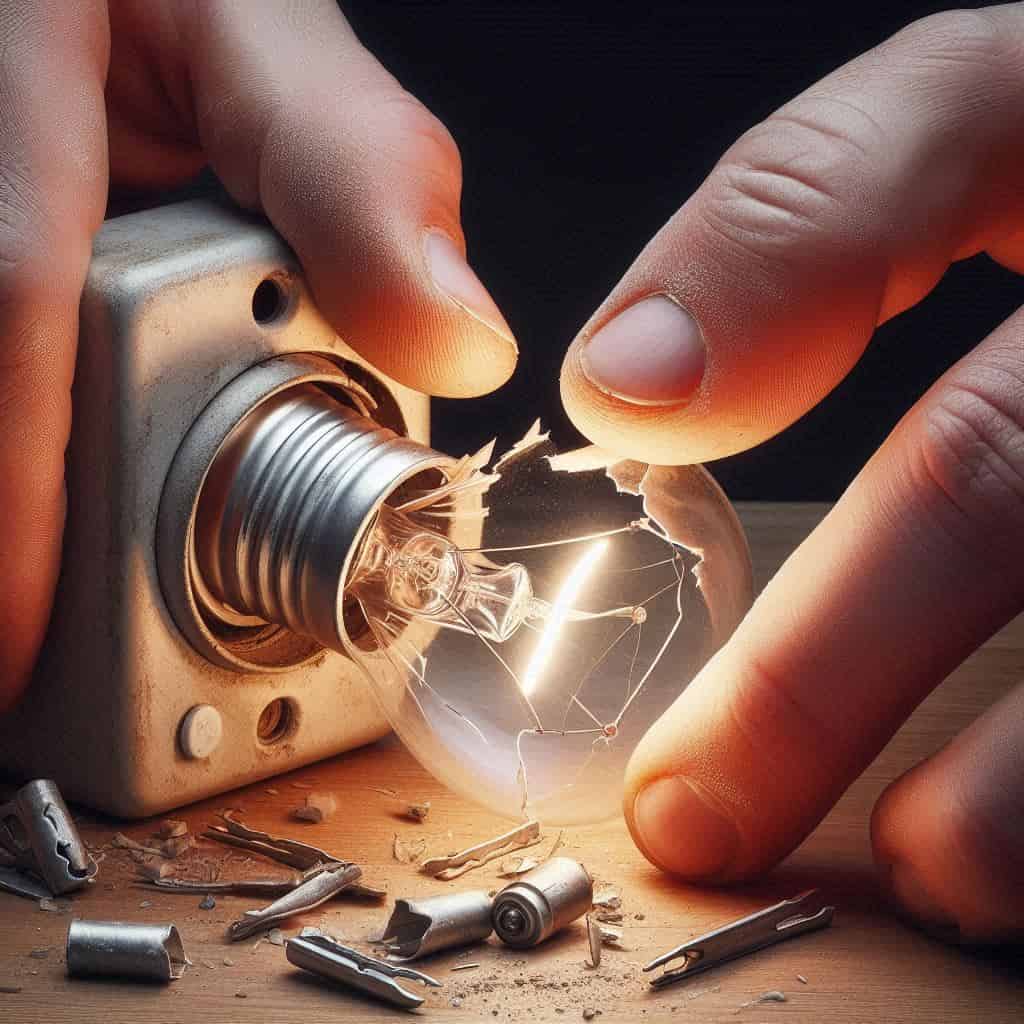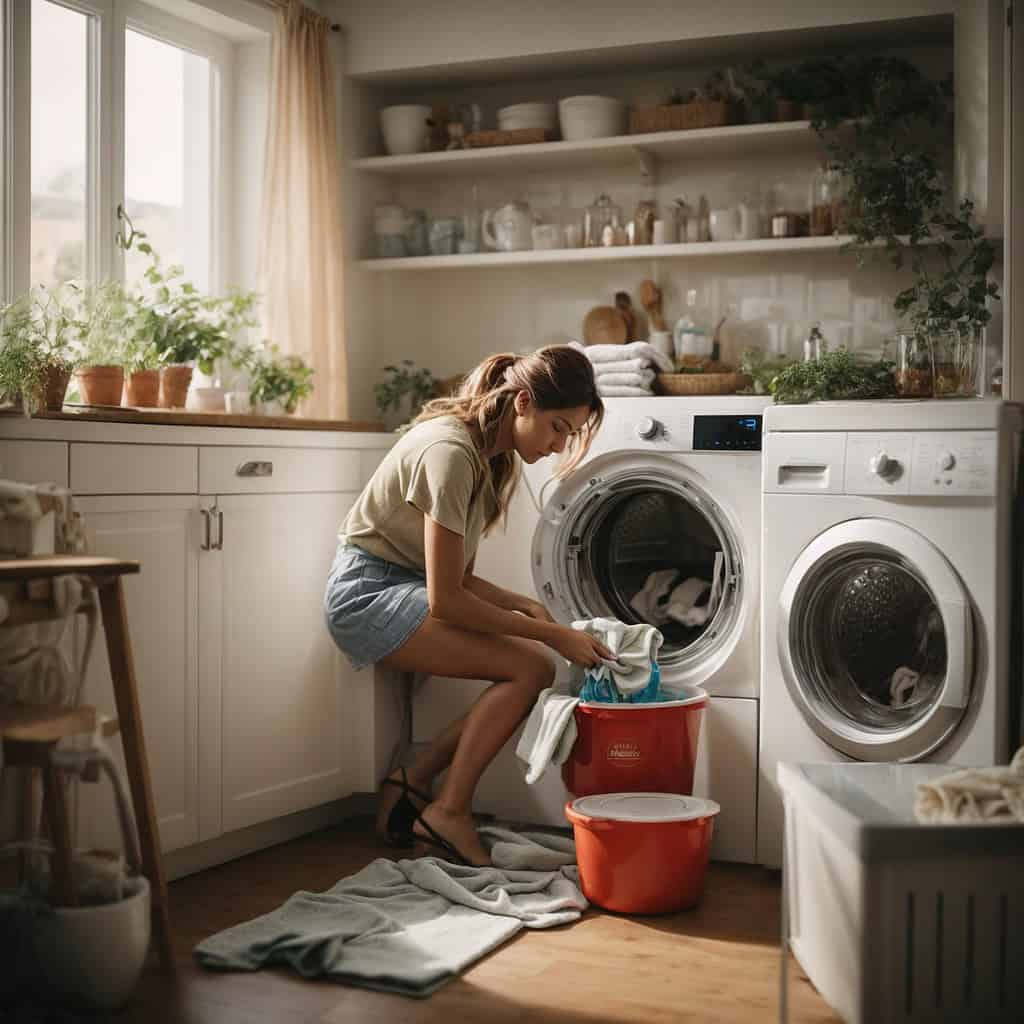
Removing a stuck light bulb can be a tricky and sometimes hazardous task. Doing it safely is essential to avoid injuries and damage to your light fixtures. This guide will walk you through the common mistakes to avoid when removing a stuck light bulb, offering practical methods and tools for effective removal.
10 Common Causes of Stuck Light Bulbs
Understanding why a light bulb gets stuck can help you prevent it from happening in the future. Here are some common causes:
Corrosion
Over time, exposure to moisture and air can lead to rust or corrosion on the metal parts of the bulb and socket. This corrosion can create a tight fit that makes it difficult to unscrew the bulb. Corroded areas may bond together, causing significant resistance when you try to turn the bulb. To mitigate this, consider:
- Using a light coat of dielectric grease on new bulbs to prevent future corrosion.
- Regularly inspecting and cleaning your fixtures to remove any early signs of rust.
Over-tightening
When a bulb is screwed in too tightly, it can become challenging to remove later. Over-tightening compresses the bulb’s base against the socket, creating friction that hinders easy removal. Additionally, this practice can damage both the bulb and socket over time. To avoid over-tightening:
- Turn the bulb until it is snug but not overly tight.
- Use a gentle hand when installing bulbs, ensuring they are seated properly without excessive force.
Heat Expansion
When a light bulb is left on for an extended period, the heat generated can cause the bulb and its components to expand. This thermal expansion can make the bulb fit more tightly within the socket. Once you turn off the light and the bulb cools down, it contracts, potentially making it harder to unscrew. The change in size might create additional friction or even bond parts of the bulb to the socket temporarily. To manage this issue effectively:
- Wait for Cooling: Always allow the bulb to cool down completely before attempting removal.
- Use Protective Gloves: Consider wearing gloves to protect your hands from any residual heat and to gain a better grip.
Broken Glass
A broken bulb presents its own set of challenges. When the glass shatters, it often leaves jagged edges that are difficult and dangerous to handle. The sharp fragments not only make it tricky to get a secure grip but also pose a risk of cuts or injury. Additionally, without the full structure of the bulb, you lose leverage needed for easy turning. To safely deal with broken glass bulbs:
- Safety First: Always switch off power at the circuit breaker before handling a broken bulb.
- Use Tools: Employ specialized tools like a broken bulb extractor or pliers with rubber-coated handles.
- Protective Measures: Wear safety goggles and thick gloves to prevent injury from sharp glass shards.
Socket Damage
A damaged or warped socket can hold the bulb too tightly, making it hard to remove. Common causes of socket damage include:
- Overheating: Excessive heat over time can warp the socket, making it grip the bulb more tightly.
- Corrosion: Exposure to moisture can cause corrosion, which may result in the socket not releasing the bulb easily.
- Physical Wear: Repeated use and frequent bulb changes can degrade the socket material, leading to a tighter grip on the bulb.
Bulb Type
Certain types of bulbs, such as compact fluorescents (CFLs), may have different designs that can contribute to them getting stuck more easily. Key factors include:
- Base Design: Some CFLs have a two-pin base instead of a screw base, which may seize up due to misalignment or wear.
- Material Differences: CFLs often use different materials compared to incandescent bulbs, which might expand differently when heated.
- Size Variations: Bulbs that are slightly larger in diameter may fit more snugly into sockets, making removal challenging.
Dirt and Debris
Accumulation of dust or debris in the socket can interfere with the bulb’s removal. This buildup can occur due to several reasons:
- Environmental Factors: Dusty environments or areas prone to debris accumulation can cause particles to gather in the socket.
- Lack of Maintenance: Infrequent cleaning and maintenance of light fixtures allow dirt and debris to build up over time.
- Insect Activity: In some cases, insects may nest around light fixtures, contributing additional debris that complicates bulb removal.
Old Age
Older bulbs may have become brittle, making them more prone to getting stuck. Over time, the filament and internal components of a light bulb degrade, which can cause the glass to weaken and crack under minimal pressure. Key factors contributing to this include:
- Material Degradation: The materials used in older bulbs, such as the glass and metal contacts, can deteriorate over years of use.
- Frequent Use: Bulbs that have been turned on and off frequently are more likely to exhibit signs of wear and tear.
- Environmental Conditions: Exposure to extreme temperatures or humidity can accelerate the aging process, making the bulb more susceptible to breaking or sticking.
Improper Installation
If the bulb wasn’t installed correctly, it may not turn smoothly and could get stuck. This often happens due to:
- Overtightening: Applying too much force when screwing in a bulb can cause it to become overly tight, making future removal difficult.
- Misalignment: Misaligned installation can lead to uneven pressure on the bulb’s base, causing it to jam within the socket.
- Use of Incorrect Bulb Type: Inserting a bulb that is not suited for the socket type can lead to fitting issues that hinder smooth installation and removal.
Electrical Issues
Sometimes, electrical issues can lead to a bulb becoming hot and fusing to the socket. These issues might include:
- Overheating: Excessive heat from prolonged use or high wattage bulbs can cause the socket material to expand and grip the bulb more tightly.
- Voltage Fluctuations: Inconsistent electrical currents can generate excess heat, further increasing the risk of a bulb becoming stuck.
Once you understand these nuances, you can adopt safer and more effective methods for removing stuck light bulbs in various scenarios.
Safety First : Precautions to Take
When dealing with a stuck light bulb, prioritizing safety is essential. Improper handling can lead to electrical shocks or injuries from broken glass. Following a few key precautions can help ensure your safety throughout the process.
Turn Off the Breaker!
Before you even touch the light bulb, turn off the power at the breaker box. This step eliminates any risk of electrical shock. Simply flipping the wall switch off isn’t enough since some circuits may still carry a small amount of current.
If you are paranoid like me 😄, you may want to use a non-contact voltage detector to confirm that there is no electricity flowing to the socket. Removing power from the equation allows you to work confidently and safely.
[amazon bestseller =”non-contact voltage detector” items=”1″]Recommended Safety Gear
Wearing the right safety gear can prevent injuries:
- Gloves: Choose sturdy, cut-resistant gloves to protect your hands from broken glass and sharp edges.
- Safety Glasses: Shield your eyes from potential glass shards by wearing goggles or safety glasses.
By taking these simple steps, you significantly reduce the risks associated with removing a stuck light bulb. For additional guidance on safely handling household repairs, check out this guide on fixing a broken doorknob or garbage disposal unit.
Equipped with these precautions, you’re now ready to gather the necessary tools and tackle that stubborn bulb safely. 💪🏼
Tools You Might Need
Successfully removing a stuck light bulb often hinges on having the right tools at your disposal. Here are some essential tools that can aid in safe and effective removal:
Suction Cups
Suction cups are particularly useful for flat-bottomed bulbs, such as those found in ceiling can fixtures. They provide a strong grip without requiring direct contact with the glass part of the bulb.
Duct Tape
Duct tape is another versatile tool that can be used to extract both standard pear-shaped bulbs and other types.
Additional Handy Tools
Tool |
Purpose |
|---|---|
| Pliers / Tweezers | Use for grip if the bulb is too tight to turn by hand. Using tweezers is perfect for tight spaces or small bulbs where larger tools might not fit. |
| Rubber Jar Opener | Provides extra grip to twist the bulb without slipping. |
| Duct Tape | Create a handle by wrapping tape around the bulb, leaving a tab for you to pull. |
| Screwdriver | For prying if the base is stuck and needs a little leverage. |
| Vacuum Cleaner | To clean up any glass if the bulb breaks during removal. |
| Light Bulb Changing Tool | Specialized tool designed specifically for removing stuck bulbs. |
| Heat Gun or Hair Dryer | Apply heat to the base (if it’s a metal socket) to expand it slightly and loosen the bulb. |
| Lubricant Spray | Use sparingly on the socket to help ease the bulb out. |
Using these tools effectively can make all the difference when dealing with stubborn light bulbs.
Types of Stuck Light Bulbs
| Type of Stuck Light Bulb | Causes | Removal Method |
|---|---|---|
| Corroded Light Bulb | Corrosion due to moisture or age | Using a lubricant to loosen the bulb |
| Heat or Moisture Damaged Bulb | Excessive heat or moisture causing the bulb to fuse with the socket | Gently wiggling the bulb to loosen it |
| Improperly Installed Bulb | Incorrect alignment or threading | Using a light bulb removal tool or rubber gloves for better grip |
Understanding the specific type of stuck bulb you have will help you determine the best course of action for safe and successful removal.
Methods to Remove a Stuck Light Bulb
Suction Cup Method
The suction cup method is one of the most effective ways to remove a stuck light bulb, especially for flat-bottomed bulbs in ceiling can fixtures. This method leverages the power of suction to provide a strong grip on the bulb, allowing you to twist it out safely.
Step-by-Step Guide on Using Suction Cups Effectively
- Turn Off the Power: Ensure that the power supply to the light fixture is turned off at the breaker box. Use a non-contact voltage detector to confirm that there is no electrical current.
- Prepare the Suction Cup: Choose a suction cup that fits well over the surface of your light bulb. If you’re using it on a flat-bottomed bulb, wetting the suction cup slightly can help create a tighter seal.
- Attach the Suction Cup: Press the suction cup firmly against the center of the bulb’s surface. Make sure it sticks securely before proceeding.
- Twist and Remove: Gently twist the suction cup counterclockwise. The firm grip should allow you to loosen and remove the bulb without breaking it.
Tips for Achieving a Good Grip
- Clean Surface: Ensure both the bulb and suction cup are clean and free from dust or grease for maximum adhesion.
- Firm Pressure: Apply steady, even pressure when attaching and turning the suction cup.
- Patience is Key: Avoid using excessive force; patience ensures you don’t damage either the bulb or fixture.
Employing these steps effectively minimizes risks and makes removing stuck bulbs safer.
Duct Tape Technique
Duct tape can also be an excellent tool for removing stubborn light bulbs by providing additional leverage.
How to Use Duct Tape
- Cut Strips of Tape: Cut two long strips of duct tape, each about 12-18 inches in length.
- Create Handles: Attach each strip’s middle section to opposite sides of the light bulb, leaving equal lengths hanging down on each side.
- Form Handles: Fold each hanging end back onto itself, creating two strong handles.
- Twist and Turn: Firmly hold both handles and twist counter-clockwise to unscrew the bulb.
Best Practices for Applying Duct Tape
- Avoid Squeezing Bulb: When applying tape, avoid squeezing too hard as this might break fragile glass.
- Check Tape Adhesion: Ensure that the duct tape is securely attached before attempting to twist.
Additional Techniques
Sometimes traditional methods may not suffice, requiring creative solutions.
Use Gloves
- Protect Your Hands: Wear rubber gloves for better grip and protection against sharp edges if the glass breaks.
- The added friction from gloves can help you twist and pull more effectively.
Heat Application
Using heat from a blow dryer can help expand the socket or loosen corrosion:
- Set Blow Dryer on Low Heat: Aim it at the base of the stuck bulb for a few minutes.
- Test Loosening: Attempt twisting again after heating; expansion may make removal easier.
Employ Pliers or Tweezers for Tight Spaces
For small bulbs or tight spaces:
- Use Needle-Nose Pliers or Tweezers: Carefully grip and turn counter-clockwise without applying too much pressure.
- Work Slowly: Gentle movements reduce breakage risk.
Wedge a Rubber Band
- Grip Enhancement: Place a thick rubber band around the base of the bulb for extra traction.
- It will allow you to grip it firmly while twisting it counterclockwise to unscrew it.
Unconventional Methods
Raw Potato Method: Cut a raw potato in half and press its flat side against broken glass remnants, then twist gently.
Soda Bottle Method: Fit an empty soda bottle over small broken bases, use adhesive if necessary to secure, then twist out.
Soak in Vinegar [Corrosion Breaker]: If rust is causing stickiness, soak a cloth in vinegar and wrap it around where metal meets glass. Let it sit for about 15-20 minutes before trying again; this may loosen any corrosion holding it in place.
Apply Oil or Lubricant [Loosening Agent]: A few drops of penetrating oil (like WD-40) applied carefully at junctions can help reduce friction caused by rust or debris. Allow some time for penetration before attempting removal again.
These alternative techniques can be lifesavers when dealing with particularly stubborn or broken bulbs.
When All Else Fails 🚨
If none of these methods work, don’t hesitate to call an electrician who has specialized tools designed specifically for this purpose. Safety should always come first if you’re uncomfortable continuing yourself. Removing a stuck light bulb requires patience and care but utilizing these practical techniques can make all the difference!
Remember to always prioritize safety by ensuring power is off during your attempts, and consider seeking professional assistance when necessary!
10 Common Mistakes to Avoid
When trying to remove a stuck light bulb, it’s important to proceed carefully to avoid injury or damage. Here are ten common mistakes to steer clear of:
# |
Mistake |
Explanation |
|---|---|---|
| 1 | Forgetting to Turn Off the Power | Always ensure the power is off at the switch or circuit breaker before attempting to remove the bulb. |
| 2 | Using Excessive Force | Applying too much pressure can break the bulb or damage the socket. Use gentle, steady pressure instead. |
| 3 | Not Wearing Protective Gear | Failing to wear safety gloves and goggles can lead to injuries if the bulb shatters. |
| 4 | Ignoring the Type of Bulb | Different bulbs (incandescent, LED, CFL) may require different removal techniques. Know what type you’re dealing with. |
| 5 | Using Improper Tools | Avoid using tools that can damage the bulb or socket. Stick to hand tools designed for this purpose. |
| 6 | Neglecting to Check for Heat | If the bulb has been on, it may be hot. Allow it to cool down before attempting removal to prevent burns. |
| 7 | Not Using Lubrication When Needed | If the bulb is stuck due to corrosion, using a lubricant like WD-40 can help. Just be cautious not to apply too much. |
| 8 | Failing to Assess the Situation | Before starting, take a moment to examine how the bulb is seated in the socket and identify any issues. |
| 9 | Rushing the Process | Taking your time can help you avoid mistakes. Patience is key when dealing with a stubborn bulb. |
| 10 | Neglecting to Seek Help | If you’re struggling, it’s okay to ask someone for assistance or consult a professional rather than risking injury. |
Once you avoid these common mistakes, you can increase your chances of safely and successfully removing a stuck light bulb!
Preventing Future Issues with Stuck Bulbs
Regular maintenance and checks on sockets and bulbs are crucial for preventing stuck light bulbs. By periodically inspecting your light fixtures, you can identify and address potential issues before they become problematic.
Look for signs of corrosion or wear on the bulb bases and sockets, and ensure they are clean and free from debris.
Best Practices for Handling and Installing New Bulbs:
- Lubricate Bulb Threads: Applying a thin layer of Vaseline or a specialized light bulb lubricant to the threads before installation helps reduce friction. This simple step can significantly decrease the chances of the bulb getting stuck due to corrosion or tight threading.
- Avoid Over-Tightening: When installing a new bulb, twist it until it’s snug but avoid using excessive force. Over-tightening can make future removal difficult and may damage the socket.
- Choose Quality Bulbs: Opt for LED bulbs which generally have sturdier bases compared to traditional incandescent bulbs. High-quality bulbs are less prone to breakage and sticking.
- Inspect Sockets Regularly: Check sockets for corrosion signs, especially in damp areas like bathrooms or outdoor fixtures. Clean them as needed using a dry cloth to maintain good electrical contact.
Regular checks and mindful installation can save you time and hassle, ensuring your lighting fixtures remain safe and functional.
Summing Up
Tackling home repairs, like removing a stuck light bulb, doesn’t have to be intimidating. Using the right tools and techniques, anyone can safely manage this common issue. Remember:
- Safety First: Always turn off the power and wear protective gear.
- Use the Right Tools: Employ suction cups, duct tape, or even household items like raw potatoes for effective removal.
- Regular Maintenance: Prevent future issues by regularly checking your bulbs and sockets.
Maintaining safe lighting fixtures at home ensures functionality and contributes to a safer living environment. So next time you face a tricky light bulb situation, approach it with confidence and the right know-how.
Embrace these tips and keep your home well-lit and safe!

Dave Johnson is a mechanical engineer with over two decades of experience in the semiconductor industry. He’s known for his exceptional ability to fix almost any mechanical and electronic device, from leaking faucets to lawnmowers – he is definitely your go-to neighbor for household maintenance issues. When he’s not elbow-deep in his garage doing household repairs, you’ll find him sharing his expertise on fixing everyday maintenance challenges on this site.


